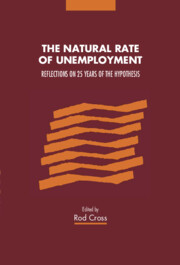Book contents
- Frontmatter
- Contents
- List of Contributors
- Preface
- 1 Introduction
- Part I The theoretical framework
- 2 The origins and further development of the natural rate of unemployment
- 3 The natural rate as new classical macroeconomics
- 4 Theoretical reflections on the ‘natural rate of unemployment‘
- 5 Of coconuts, decomposition, and a jackass: the genealogy of the natural rate
- Part II Adjustment, ranges of equilibria and hysteresis
- Part III Empirical tests and macro models
- Part IV Political economy
- Index
5 - Of coconuts, decomposition, and a jackass: the genealogy of the natural rate
Published online by Cambridge University Press: 03 May 2011
- Frontmatter
- Contents
- List of Contributors
- Preface
- 1 Introduction
- Part I The theoretical framework
- 2 The origins and further development of the natural rate of unemployment
- 3 The natural rate as new classical macroeconomics
- 4 Theoretical reflections on the ‘natural rate of unemployment‘
- 5 Of coconuts, decomposition, and a jackass: the genealogy of the natural rate
- Part II Adjustment, ranges of equilibria and hysteresis
- Part III Empirical tests and macro models
- Part IV Political economy
- Index
Summary
Introduction
The concept of the natural rate of unemployment was formulated in 1968, by Friedman and Phelps. In Friedman, it plays the central role in his theory of the relationship between short-run and long-run Phillips curve. However, in this chapter, I will focus not on its role within the theory of inflation per se, but rather on the fundamental notion of equilibrium, the natural rate itself. The natural rate stands in a tradition of ideas that may be loosely called classical or monetarist. We may well ask, therefore, two questions: first, how does the idea of the natural rate (NR) differ from its predecessors; secondly, how have more recent ideas developed or diverged from it? A full and proper answer to both of these questions would require a degree of scholarship and comprehensive grasp of the broad sweep of the history of economic thought which, alas, eludes me. However, I intend to approach both questions in terms of a series of snapshots and observations which will be drawn together towards the end of the chapter. Without spoiling the story, I conclude that the natural rate as an equilibrium concept was largely derivative of Patinkin's concept of full employment, as laid out in his Money, Interest and Prices (first published in 1956). However Friedman nowhere ever lays down a specific theory of the natural rate itself, and as such the concept has proven sufficiently loose and vague to fit a variety of subsequent models of equilibrium.
- Type
- Chapter
- Information
- The Natural Rate of UnemploymentReflections on 25 Years of the Hypothesis, pp. 57 - 74Publisher: Cambridge University PressPrint publication year: 1995
- 5
- Cited by



